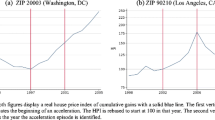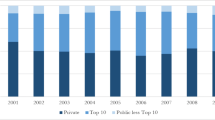Abstract
House price regression residuals often display spatial dependence but historically mortgage models, which employ house prices, assume independence and use only the own borrower/loan characteristics. This manuscript uses a spatial probit model to investigate spatial dependence among the disturbances and the effect of borrower/loan characteristics from nearby properties on own default propensity. We find that allowing spatial dependence in the disturbances greatly improve the predictive accuracy of a probit default model, and that spillovers from risky neighbor characteristics have statistically significant and material effects on own payment default propensity. In addition, measurement of spatial effects can improve policy analysis.
Similar content being viewed by others
Notes
The location related omitted variables may include property, neighborhood and borrower characteristics.
See Beron and Vijverberg (2004) as well as LeSage and Pace (2009) for other developments and motivations of spatial probit models.
The simultaneous autoregressive (SAR) specification \(\Omega _{SAR}=(I_{n}-\rho W)^{-2}\) is the most popular in spatial econometrics. The moving average (MA) specification \(\Omega _{MA}=(I_{n}+\rho W)^{2}\) appears less frequently.
For large n, the sampling variability of \(\bar d\) should be low since \({\rm{pdf}} (\varphi _{i})\) has a magnitude that is between 0 and 0.3989 (\({\rm{pdf}} (0)\)). Even when \({\rm{pdf}} (\varphi _{i})\) is not independent across i, the variability of \({\rm{pdf}} (\varphi _{i})\) is bounded and therefore its average (\(\bar d\)) should show low sampling variability. In which case, the distribution of the estimated direct, indirect, and total random effects will be dominated by the sampling variability associated with \(\tilde \beta \), \(\tilde \theta \), and \(\tilde \beta +\tilde \theta \). Also, this marginal analysis does not apply strictly to discrete explanatory variables. There are no fundamental computational barriers to obtaining more exact versions of these effects. However, the approximations in Eqs. 36–38 simplify interpretation.
There are some additional complications for interpretation that arise for models with spatially dependent disturbances and global spillovers that LeSage et al. (2011) examined in a study of business recovery in New Orleans after Katrina.
The average time lag between the transaction date and the filing date is 25 days, from the transactions with both transaction date and the filing date.
Results are about the same when 60+ days delinquency is reclassified as default.
As a robustness check, results are qualitatively similar for year 2007 to 2010.
This is indicated by the same property site address and tax billing address.
Sometimes dummy variables that cover only a small number of observations can pick up unobservables associated with these idiosyncratic observations. However, for these data the dummy variable that covered the fewest cases was the company owned dummy which nonetheless included 4.82 percentage of the 79,652 observations. Therefore, the dummy variables used in this analysis covered a substantial number of cases.
Note, the intercept in this regression and the following regressions would be associated with the base case of a non-fully documented fixed rate loan without a prepayment penalty or exotic features associated with the initial purchase of the property. Since \(y_{i}=1\) represents a default, smaller intercepts point to lower default rates for the base case.
References
Agarwal, S., Ambrose, B.W., Chomsisengphet, S., Sanders, A.B. (2012). The neighbors mortgage: Does living in a subprime neighborhood affect ones probability of default? Real Estate Economics, 40(1), 1–22.
Basu, S., & Thibodeau, T. (1998). Analysis of spatial autocorrelation in house prices. Journal of Real Estate Finance and Economics, 17, 61–85.
Beron, K.J., & Wim, P.M.V. (2004). Probit in a spatial context: a Monte Carlo analysis. Advances in spatial econometrics, (pp. 169–195). Berlin Heidelberg: Springer.
Can, A.S., & Megbolugbe, I. (1997). Spatial dependence and house price index construction. Journal of Real Estate Finance and Economics, 14, 203–222.
Crook, J.N., Edelman, D.B., Thomas, L.C. (2007). Recent developments in consumer credit risk assessment. European Journal of Operational Research, 183, 1447–1465.
Elhorst, P. (2010). Applied spatial econometrics: raising the bar. Spatial Economic Analysis, 5(1), 9–28.
Foote, C.L., Gerardi, K., Willen, P.S. (2008). Negative equity and foreclosure: theory and evidence. Journal of Urban Economics, 64, 234–245.
Harding, J.P., Rosenblatt, E., Yao, V.W. (2009). The contagion effect of foreclosed properties. Journal of Urban Economics, 66, 164–178.
Ioannides, Y. (2002). Interactive property valuations. Journal of Urban Economics, 53, 145–170.
Kau, J.B., Keenan, D.C., Kim, T. (1993). Transaction costs, suboptimal termination, and default probabilities. Journal of American Real Estate and Urban Economics Association, 21, 247–264.
Kau, J.B., Keenan, D.C., Kim, T. (1994). Default probabilities for mortgages. Journal of Urban Economics, 35, 278–296.
LeSage, J.P., & Pace, R.K. (2004). Models for spatially dependent missing data. The Journal of Real Estate Finance and Economics, 29, 233–254.
LeSage, J.P., & Pace, R.K. (2009). Introduction to spatial econometrics. Boca Raton: CRC Press.
LeSage, J.P., Pace, R.K., Lam, N., Campanella, R., Liu, L. (2011). New Orleans business recovery in the aftermath of Hurricane Katrina. Journal of the Royal Statistical Society: Series A (Statistics in Society), 174(4), 1007–1027.
Pace, R.K., Ronald, B., Sirmans, C.F. (1998). Spatial statistics and real estate. The Journal of Real Estate Finance and Economics, 17(1), 5–13.
Pace, R.K., & LeSage, J.P. (2011). Fast simulated maximum likelihood estimation of the spatial probit model suitable for large n. SSRN working paper.
Pace, R.K., LeSage, J.P., Zhu, S. (2012). Spatial Dependence in regressors and its effect on performance of likelihood-based and instrumental variable estimators. Advances in Econometrics, 30, 257–295.
Pace, R.K., & Zhu, S. (2012). Separable spatial modeling of spillovers and dependence. Journal of Geographical Systems, 14, 75–90.
Phinikettos, I., & Gandy, A. (2011). Fast computation of high-dimensional multivariate normal probabilities. Computational Statistics and Data Analysis, 55, 1521–1529.
Ramalho, E.A., & Ramalho, J.J.S. (2010). Is neglected heterogeneity really an issue in binary and fractional regression models? A simulation exercise for logit, probit and loglog models. Computational Statistics and Data Analysis, 54, 987–1001.
Seiler, M., Lane M., Harrison, D. (2011). Mimetic herding behavior and the decision to strategically default. In Maastricht-NUS-MIT symposium.
Yatchew, A., & Griliches, Z. (1985). Specification error in probit models. Review of Economics and Statistics, 67, 134–139.
Acknowledgments
The authors would like to thank the helpful comments from Paulo Rodrigues, Peng Liu, and other participants in LSU seminar, KSU seminar, 2011 MIT-NUS-Maastricht real estate research symposium and 2012 FMA conference. We would like to thank the very helpful comments from John Clapp. The authors would like to acknowledge support for this research provided by the National Science Foundation (BCS-0136193, SES-0554937, and SES-0729264). The statements, findings, conclusions, and recommendations are those of the authors and do not necessarily reflect the views of the National Science Foundation. In addition, Pace would like to acknowledge support from the BP-LSU Oil Spill grant. We appreciate the support from Blackbox Logic, LSU High Performance Computing Center, LSU and KSU Finance department. All errors are our own.
Author information
Authors and Affiliations
Corresponding authors
Rights and permissions
About this article
Cite this article
Zhu, S., Pace, R.K. Modeling Spatially Interdependent Mortgage Decisions. J Real Estate Finan Econ 49, 598–620 (2014). https://doi.org/10.1007/s11146-013-9419-y
Published:
Issue Date:
DOI: https://doi.org/10.1007/s11146-013-9419-y




